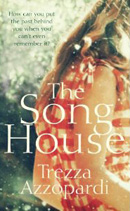
The UK is awash with misery memoirs. From children kept in cellars, to those pimped out by their (usually alcoholic) parents, or merely left to fend for themselves in poverty, the appetite for the contents of the 'Tragic Lives' section seems insatiable: just under £1 million was spent on the top 20 titles during the first quarter of 2010, (according to The Bookseller). Trezza Azzopardi's Booker-shortlisted first novel, The Hiding Place, tapped into this interest in the dark undercurrents of family life, and she has continued to chew over the topic in subsequent books.
The Song House once again revives the theme of past secrets. Maggie Nix turns up at Earl House in a freakish heatwave, interviewing for a job as assistant to the elderly Kenneth Earl. Increasingly aware of the shortcomings of his own memory, Kenneth has decided he needs to create a memoir, constructed around his voluminous library of recordings. Charmed by Maggie, he offers her the job, unaware that her motives for applying are primarily to do with the laying of old ghosts.
Opening in a cornfield on a fiercely hot summer's day, The Song House is a book suffused with sound. From its first words, "She's hearing things" , we're enveloped in the noise of the landscape in which Earl House sits, and of its occupants and their possessions. Azzopardi has commented in an earlier interview (with the website ReadySteadyBook) that she is fascinated by the split between "two worlds - the spoken and unspoken.... thoughts can take the form of colours, smells and sensations", and throughout her new novel, the characters' inner lives are manifested through the senses.
The Song House is centrally concerned with exploring the nature of that "slippery thing", memory. Azzopardi parallels Kenneth's memories-in-music project with Maggie's own 'journal': Maggie's attempts to process her own past fill the pages of the notebook she is supposed to be using for Kenneth's memoir, and are interspersed through the novel. The narration of Maggie's past can occasionally feel strained: she frequently ventriloquises for her mother in her 'journal' passages, describing scenes she could not have witnessed, or exploring emotions she could not have experienced or understood at the time. Despite this occasional jarring, though, the journal passages do serve to highlight the essential dishonesty of storytelling; all of the novel's characters are telling stories, explicitly or implicitly, and none of them are the whole truth.
From Maggie's first spreadeagling in the cornfield during the book's opening pages, to the apocalyptic
deluge and flood that bring the novel to a close, the landscape of The Song House is vividly
realised. In its use of 1970s period detail too, the novel is at times reminiscent of David
Mitchell's Black Swan Green, albeit without that book's humour. This isn't meant as a
criticism: the teenage hero of Mitchell's book survives his experiences by laughing at himself,
but Maggie's rather grimmer childhood doesn't leave much room for amusement. Azzopardi's mastery
over misery has strengthened significantly, however; The Song House allows her characters
far greater room to breathe and to grow out of the shadow of the past, resulting in a book that
is intensely felt and beautifully written.

Picador, hardcover, 9780330461030
